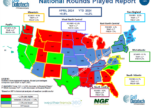SHOT EUPHORIA
The ability to play well, even to hit a single shot, creates what the National Golf Foundation describes as
“shot euphoria.”
Equipment manufacturers attempt to describe the benefits of their clubs clearly, i.e., the ball will fly “longer, straighter, higher and will stop quicker on the green,” using a complex set of terminology incomprehensible to the layperson. They have the simple goal of differentiating the various models they manufacture from those competitors offer.
PERMUTATIONS A PLENTY
Do you know the difference between muscle back (solid back) and cavity back (hollow) clubs? Which is more workable – muscle back or cavity back? Which is more forgiving – muscle-back or cavity-backed? What about between forged (softer) or cast blade (harder)?
Do you know the difference between the materials used to manufacture the clubs (steel, graphite, titanium, composites)? Are you under the impression that irons four through wedge all have the same lofts that progress evenly throughout the set, starting with 21 degrees for the four irons to 45 degrees for the wedge?
Why are there differences in the gram weight of shafts (50 to 110) and their flex (extra stiff >105 mph swing speed, stiff 87-104 mph, regular 84 – 96 mph, senior 72 – 83 mph, and Ladies < 72 mph matter? Can one buy a set of irons where the gap between the wedge and the gap wedge is more than six degrees, where four degrees is desired?
What percentage of golfers know their clubhead speed? I would venture a guess than that 20%, thus making any purchase akin to buying a lottery ticket, hoping it is a winner. What percentage of golfers have ordered custom-made clubs? While 55% of golfers who play more than 16 rounds probably get fitted for clubs, I would venture for the masses less than 10% do.
Do the club’s Tour players use the same loft as the high-handicap golfers? No, the loft on a tour four-iron is about three degrees (21 – 24) higher than a high-handicap golfer’s four-iron (19 – 22) degrees. Manufacturers deceive handicapped golfers into thinking they are hitting longer when only the loft has been lowered.
THE SEARCH
This year has been a constant search for the proper set of irons. The badges (back panel) on the Ping I 210, purchased with custom fitting in 2020, were 80 grams—Aerotech Steel Fiber Regular Flex—came loose on all the irons, exposing the elastic polymer. Foolishly, I upgraded to Ping I 230 irons at $2,400 in April 2024 based on the same specifications, not considering I was four years older and my swing probably was slower.
In late August and early this month, September 2024, I went to get custom fitted at Golf Galaxy with a Callaway representative who was launching the Apex Ai200, Ai 300, T1 Fusion, True Spec, and at PGA Superstore, hoping to find the best set of irons (four to wedge) for me to play.
I thought all of the fitters were extremely professional and very helpful.
At Golf Galaxy, the fitter recommended Callaway T1 Fusion, 70-gram, senior flex UST Mamiya Recoil Dart shaft. Cost with Winn mid-size grips: $2,308.
True Spec recommended the Callaway T1 Fusion 55-gram shaft with a UST Mamiya Quantum speed flex shaft. The cost with Winn mid-size grips and shaft pure is $2,975. Delivery is four to six weeks.
PGA’s Superstore recommendation was Ping I530, Green dot (2+ Up), Standard Loft (Not Power or Retro Lofts), Aldila (manufactured for Ping) Alta CB Black 65-gram soft regular flex with Winn mid-size grips: $1,463.00. Shafts are back ordered until October 4.
I tested the various club heads with the 7-iron at a wide range of distances from 142 to 185. As for the right club head to buy, I have no clue, as the lofts varied on the irons, and the softness and sound of the ball hitting the clubface were so different.
My simple goal is to hit a 7-iron 150 yards at 5,280 feet above sea level with my ability to feel the ball contacting the clubface like “butter” (T1 Fusion when hit correctly) vs. “concrete” (any Ping iron).
THE LESSON FOR ME
With a drive swing speed of 89.5 mph, I am facing the option 70-gram shaft with either a regular or flex graphic shaft. The Graphite shaft (perhaps UST Mamiya Recoil Dart or Quantum Speed UST was consistently better than the Aerotech Steel Fiber. PGA Superstore cautioned me against the Aerotech Steel Fiber shaft as True Temper recently bought the company, and the implications are unknown.
THE LESSON FOR YOUR GOLFER
Below is a chart of 17 models by five leading manufacturers highlighting whether the clubs are designed for professional, low, low to mid, mid-high, or high handicappers and the associated lofts on each set of irons.
| Callaway Ai200 | Callaway Ai300 | Callaway T1 Fusion | Mizuno JPX 241 | Mizuno JPX 243 | Mizuno JPX 245 | Mizuno JPX 923 | Mizuno JPX 925 | Ping I230 | Ping i530 | Ping G730 | TaylorMade P770 | TaylorMade 790 | Titleist T100 | Titleist T150 | Titleist T200 | Titleist T300 | |||||||||
| Low to Mid | Mid to High | Low to Mid | Professional | Low | Low to Mid | Mid to High | Mid to High | Low to Mid | Low to Mid | Mid to High | Low to Mid | Mid to High | Low | Low to Mid | Mid | Mid to High | |||||||||
| 3-iron | 19.0 | 19.0 | 19.0 | 19.0 | 21.0 | 19.0 | — | — | |||||||||||||||||
| 4-iron | 21.0 | 20.0 | 21.0 | 24.0 | 22.0 | 19.0 | 21.0 | 19.0 | 22.5 | 19.0 | 22.0 | 21.0 | 24.0 | 22.0 | 21.0 | 20.0 | |||||||||
| 5-iron | 23.0 | 22.0 | 23.5 | 27.0 | 25.0 | 21.5 | 24.0 | 22.0 | 26.0 | 22.0 | 21.5 | 25.5 | 23.5 | 27.0 | 25.0 | 24.0 | 23.0 | ||||||||
| 6-iron | 26.0 | 25.0 | 26.5 | 30.0 | 28.0 | 24.0 | 27.0 | 25.0 | 29.5 | 25.5 | 24.5 | 29.0 | 26.5 | 30.0 | 28.0 | 27.0 | 26.0 | ||||||||
| 7-iron | 30.0 | 29.0 | 30.5 | 34.0 | 32.0 | 27.0 | 30.0 | 28.0 | 33.0 | 29.0 | 28.0 | 33.0 | 30.5 | 34.0 | 32.0 | 30.5 | 29.0 | ||||||||
| 8-iron | 34.0 | 33.0 | 34.5 | 38.0 | 36.0 | 30.0 | 34.0 | 32.5 | 37.0 | 33.0 | 32.0 | 37.0 | 35.0 | 38.0 | 36.0 | 34.5 | 33.0 | ||||||||
| 9-iron | 38.0 | 37.0 | 38.5 | 42.0 | 40.0 | 34.0 | 39.0 | 37.0 | 41.0 | 37.0 | 36.0 | 41.0 | 40.0 | 42.0 | 40.0 | 38.5 | 38.0 | ||||||||
| PW | 43.0 | 42.0 | 43.0 | 46.0 | 44.0 | 38.0 | 44.0 | 42.0 | 45.0 | 42.0 | 40.0 | 45.0 | 45.0 | 46.0 | 44.0 | 43.0 | 43.0 | ||||||||
| UW | 48.0 | 47.0 | 48.0 | 48.0 | 43.0 | 49.0 | 48.0 | 50.0 | 47.0 | 45.0 | 50.0 | 50.0 | 50.0 | 48.0 | 48.0 | 48.0 | |||||||||
| 50 | 48.0 | 54.0 | 50.0 | – | — | — | 50.0 | ||||||||||||||||||
| 56 | 56.0 | — | — | — | |||||||||||||||||||||
Scroll chart to the right to view additional club specifications
While I would wish that club manufacturers renamed their irons merely based on the loft like is done for drivers and the gap, sand, and lob wedges, hoping for any change within the golf industry is unlikely.
Sharing this blog with a customer who is about to get fitted may help them overcome the anxiety associated with purchasing the right set of clubs.
If golfers are properly fit, studies have shown that their scores will improve by 10%. Better scores translate into more frequent visits and higher revenue for the golf course operator. A scenario in which everyone wins.

